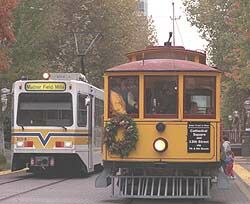
Light Rail Progress can be contacted at: Light Rail Progress |
Restoration of historic streetcar (trolley) systems continues to be a particularly interesting aspect of the ongoing surge of development of North American light rail transit (LRT). And such an historic restoration may be getting under way in Sacramento, where a longstanding heritage streetcar plan may finally be getting off the ground. As the article below from the Sacramento Bee reports, a heritage streetcar circulator system is being sponsored by a local real estate developer particularly interested in fostering transit-oriented development (TOD). The plan envisions streetcars sharing sections of the trackage and overhead contact system (OCS) with Sacramento's modern LRT system (see our article Sacramento's Light Rail: Success in a Small City). However, there are snags, as the Bee article discusses. We must note a minor technical misstatement in the article. The reporter states: And to complicate things even more, the overhead wires of the light-rail system have to be modified to accommodate the old-time cars. The modern cars run on alternating current, which the old-timers can use only with special equipment.
The main problem with joint operation is to modify the OCS to permit streetcars to pick up current with trolley poles, while continuing to enable current collection by modern pantographs on the LRT vehicles. This is the actual reason that "the overhead wires of the light-rail system have to be modified to accommodate the old-time cars."
Sacramento Bee http://www.sacbee.com/content/news/traffic/story/6271018p-7224957c.html Trolley lovers staying on track By Walt Wiley – Bee Staff Writer A plan on the drawing board for years to bring back streetcars occasionally to Sacramento's streets may soon become a partial reality. Regional Transit already owns a historic car that it rolls out on special occasions, and now four more are waiting in the wings to be restored and put to work. Friends of Light Rail, a nonprofit formed to boost the idea of light rail when it was still a gleam in the eye of city leaders, has had a historic trolley committee for more than 10 years. The group seeks ways to put the old cars back on track. Their plan is starting to gain attention. "The bulk of our focus is on newer things going on with transit, but we've kept the idea of the historic cars out there," said Seann Rooney, executive director of the booster group. Especially ardent on the topic has been Dain Domich, whose firm, Separovich Domich, designs and builds commercial real estate developments oriented toward light rail. The firm made the old trolleys a key part of its plan for the Granite Park complex beside the light-rail tracks at Power inn Road. Now, the stars appear to be in line for work to begin on restoration of the cars in a shop at Granite Park, Domich said. "We've got shop space that's finally being completed, and we'll start work as soon as we can," Domich said. His original plan at Granite Park was to install rail lines and trolley wires so that the historic cars could be used for shuttle service around the 140-acre public-private complex of offices and park settings. "But it turns out the (state Public Utilities Commission) has to get involved when there are situations like rails crossing streets, so that's been a big delay. But it's still part of the plan," he said. There are also some hitches in Friends of Light Rail's original scheme to have the old trolleys operating in a loop around the downtown area, perhaps even crossing the Sacramento River to serve Raley Field in addition to the Amtrak station and major downtown streets. It can't be done on existing rails because there just isn't room anymore, said Mike Wiley, an RT official. "It would probably work on a Sunday, but otherwise there would be problems with power draw and also with operating within our regular schedule of service, particularly after the south line is in operation," Wiley said. Further, he said, the old cars are fragile and require much maintenance. They are mostly wooden, which means constant painting and maintenance, and the frame and other metal parts are subject to fatigue and failure. And to complicate things even more, the overhead wires of the light-rail system have to be modified to accommodate the old-time cars. The modern cars run on alternating current, which the old-timers can use only with special equipment. Nevertheless, the old cars are crowd-pleasers, Wiley said. "We have car No. 35 that we run on special occasions, and everyone loves that," he said. The four more waiting in the wings to join No. 35 will be forthcoming once the restoration shop is up and running, said Richard Vantine, Friends of Light Rail's restoration guru. Vantine, an aircraft mechanic by training who works for the Siemens company at its Sacramento rail car factory, said the old-timers are a good cross-section of Sacramento's trolley-car past. They were Pacific Gas and Electric Co. cars, some originally purchased by Sacramento Electric Gas & Railway Co. around the turn of the 20th century and operated on city streets until the tracks were torn up in 1947. Most familiar, and first to be restored, he said, is old No. 65, a fully enclosed car built in 1929 that has served as a restaurant at several locations. It was part of a restaurant on Folsom Boulevard at Bradshaw Road, then in order became the J Street Trolley and the Fish Emporium at 38th and J streets, then the Fish Emporium on Fair Oaks Boulevard before it was bought by Friends of Light Rail to await restoration. Even if the old cars won't be running on the main light-rail line any time soon, Domich said he is saving room to build a connection just in case it is needed. About the Writer The Bee's Walt Wiley can be reached at (916) 321-1063 or wwiley@sacbee.com. Updated 2003/04/03 |
|
|
|